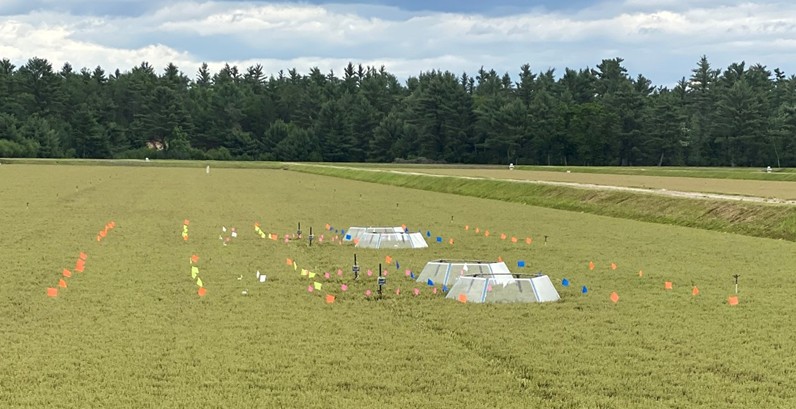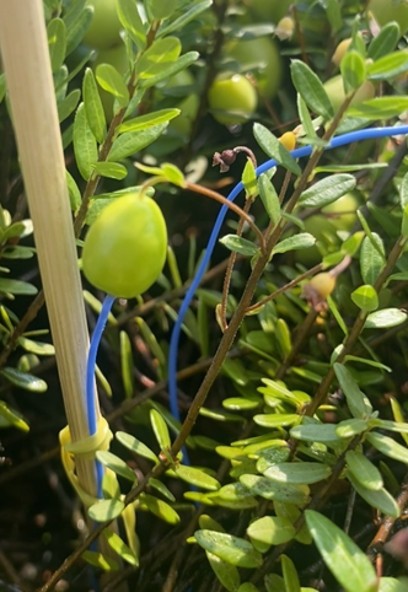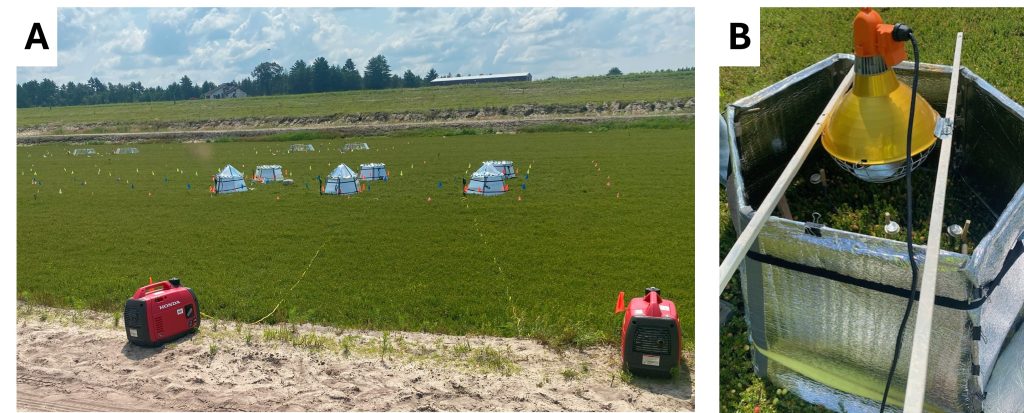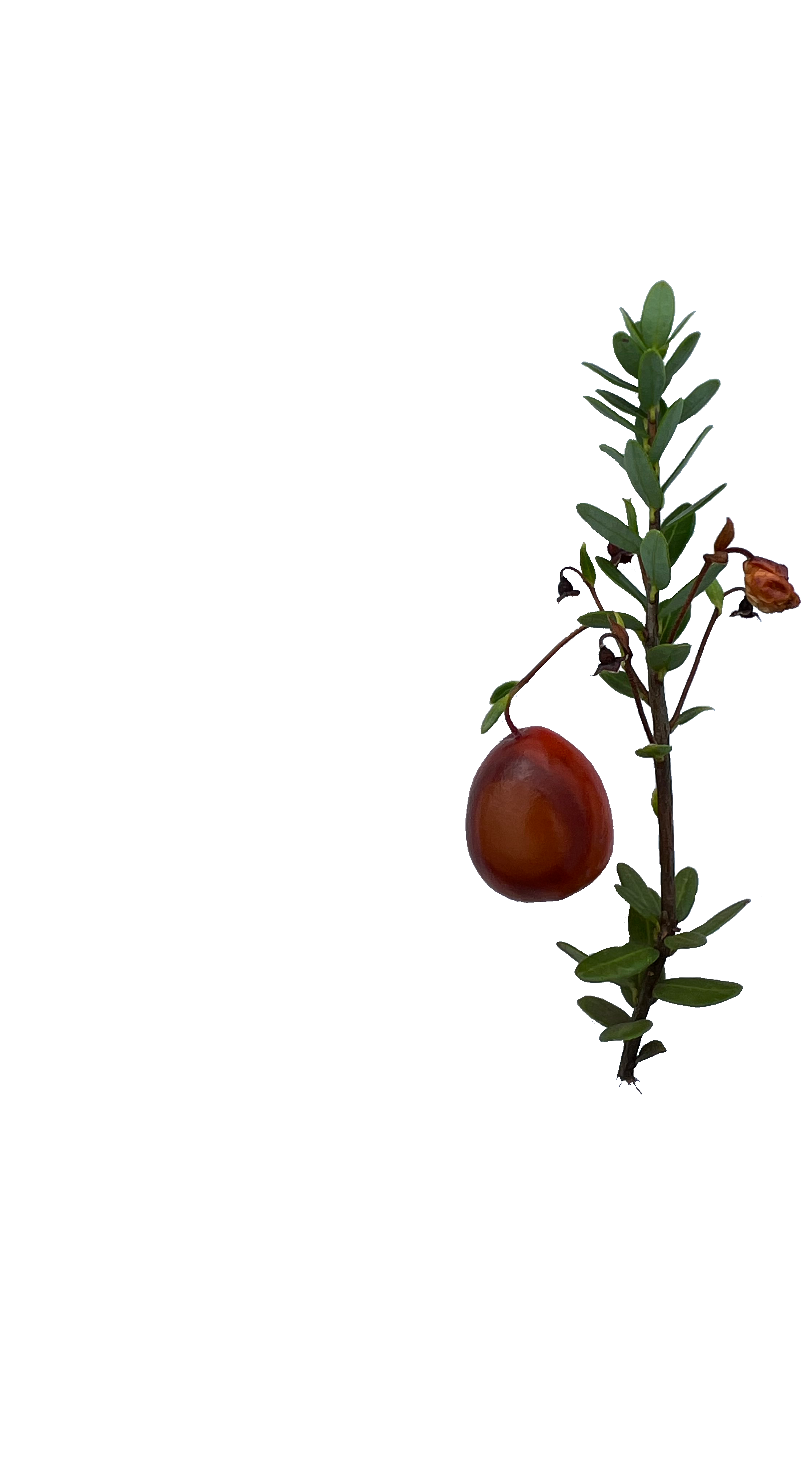As climate change intensifies, heat stress is becoming an increasingly significant concern for fruit crops, including cranberries. Across all cranberry-growing regions, growers are worried about the impact of rising temperatures on fruit quality and yield. This concern is particularly pressing in areas like New Jersey, where heat stress is already affecting cranberry production. One area of focus is whether heat stress during fruit development might be linked to an increased incidence of fruit rot, a major challenge for cranberry production.
To investigate this potential relationship, we are examining two types of heat stress: acute or short-term stress and prolonged or long-term stress. This study aims to shed light on how different heat stress scenarios affect cranberry fruit rot, providing insights to help growers mitigate these impacts.
During the 2024 growing season, we conducted both long- and short-term heat stress experiments on two commercial cranberry cultivars, ‘Mullica Queen’ and ‘Stevens’, at the Wisconsin Cranberry Research Station in Black River Falls, Wisconsin. Building on insights from a 2023 pilot study, we utilized two types of open-top chambers (OTCs) tailored for each type of heat stress. Wider and shorter OTCs were employed for long-term heat stress, as their design better retains elevated midday temperatures. In contrast, narrower and taller OTCs were used to simulate acute heat stress conditions (Figure 1).

Long-term heat stress
For the long-term heat stress experiment, we established four OTCs and four control plots per cultivar during the first week of June 2024, when cranberry plants reached the roughneck phenological stage (Figure 2). These OTCs were removed immediately before fruit harvesting in late September 2024. Throughout the period the OTCs remained in the field, canopy temperature and relative humidity were recorded every 10 minutes. Additionally, phenological data were collected weekly, and measurements of carbon assimilation and stomatal conductance were taken four times during the growing season using a CIRAS-3 Portable Photosynthesis System (PP Systems, Amesbury, MA). These measurements were used to evaluate whether higher temperatures negatively affect photosynthesis, which could in turn reduce cranberry plant productivity. This is a critical concern, as higher temperatures could potentially lead to lower yields, posing a significant challenge for cranberry growers in a warming climate.


When the fruit had set and reached the pea-size stage, we inserted micro-thermocouples through the calyx to record internal fruit temperature until harvest (Figure 3). Temperature and relative humidity data were downloaded weekly, and the micro-thermocouples were checked regularly. If necessary, new fruits were selected and monitored to ensure consistent data collection. Additionally, phenological data were collected weekly to track potential differences in plant growth and fruit development. These fruit temperature measurements were critical for assessing whether higher fruit temperatures were associated with increased fruit rot incidence, providing valuable insights into the potential impact of heat stress on cranberry fruit health.
Acute heat stress
For the acute heat stress experiment, we applied four treatments to cranberry plots at different phenological stages of fruit development: pea-size, green, blush, and red berry stages. The treatments were designed to expose plants to a temperature of 40°C (104°F) for two hours at specific stages, with each treatment involving a varying number of “pulses” or instances of heat stress.
The first treatment included four pulses applied at all four stages (pea-size, green, blush, and red berry). The second treatment involved three pulses, starting at the green stage and continuing through the blush and red berry stages. The third treatment consisted of two pulses applied at the blush and red berry stages. The final treatment included a single pulse applied only at the red berry stage. We imposed the acute heat stress at these different developmental stages to determine whether cranberry fruit is more sensitive to heat stress—and consequently more prone to developing fruit rot—at specific stages of growth. Understanding the relationship between heat stress timing and fruit rot development could inform targeted management practices to mitigate heat stress effects during the most critical stages of fruit development.
To induce acute heat stress, we used a patio lamp with a 1600-watt infrared heating element positioned at the top of each OTC. Since the experiments were conducted in the field without access to alternating current electricity, generators were used to power the lamps. Inkbird Temperature Controllers were employed to maintain a consistent temperature of 40°C ± 0.5°C for two hours. To eliminate the effects of high temperatures from solar radiation, insulated blankets were placed over all sides and the tops of the OTCs. Control OTCs were similarly covered with insulated blankets but did not include a heating element. For each treatment and heat pulse, we used three heated OTCs and three control OTCs. Each OTC was considered a biological replicate (Figure 4).

Similarly to the long-term heat stress experiment, we measured a variety of variables to help relate the effects of the treatments to potential increases in fruit rot incidence. Immediately before installing the OTCs to begin the treatment, one thermocouple was placed at canopy level, and three micro-thermocouples were inserted into three fruits at the basal position in the upright to measure canopy and internal fruit temperatures, respectively. Additionally, sensors were installed to measure relative humidity. Along with collecting temperature data during the treatments, we also monitored phenology and recorded the percentage of fruit rot prior to the treatments. This comprehensive data collection allowed us to assess the relationship between heat stress and fruit rot development.
Before the commercial fruit harvest at the Cranberry Research Station, we selected a 0.2 m² (2 square feet) area from each OTC and control plot and collected all the fruit from that area. From these samples, we evaluated several key factors including yield, the percentage of rotten versus healthy fruit, fruit morphology—such as length, width, and cuticle thickness—and fruit chemical composition, which encompassed anthocyanins, total phenolic content, as well as sugar and acid content. Additionally, plant material was collected exclusively from the long-term heat stress experiment to assess various plant traits, including fruiting upright density, upright length, rebudding, and physiological parameters such as stomatal conductance, leaf area, and leaf thickness.
In conclusion, our experiments on both long- and short-term heat stress in cranberries aim to assess the potential impact of rising temperatures on fruit quality and productivity, particularly in relation to fruit rot incidence. The data collected in 2024, including fruit yield, rot percentage, morphology, chemical composition, and various plant traits, will provide valuable insights into how heat stress affects cranberry plants at different stages of development. We are currently evaluating this data to identify potential correlations between heat stress and fruit rot. As part of a two-year study, we will repeat both the long-term and acute heat stress experiments in 2025, collecting the same comprehensive set of data to confirm our findings and deepen our understanding of how heat stress influences cranberry production. This research will ultimately help inform management strategies to mitigate the effects of heat stress and improve cranberry crop resilience in the face of climate change.
Article by Dr. Jenny Bolivar-Medina and Dr. Amaya Atucha, University of Wisconsin-Madison
